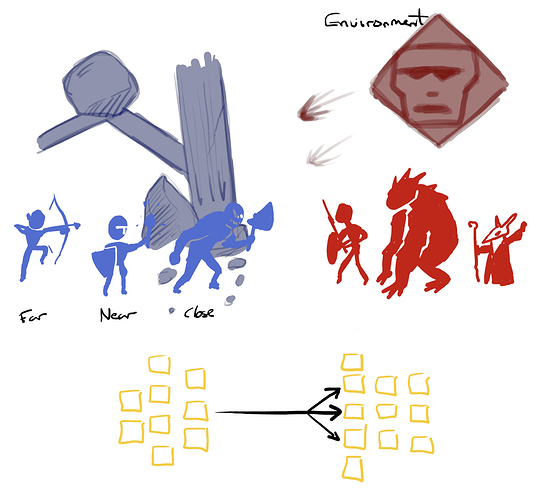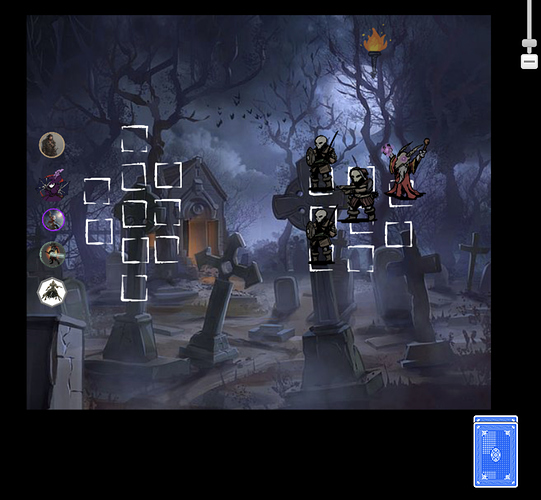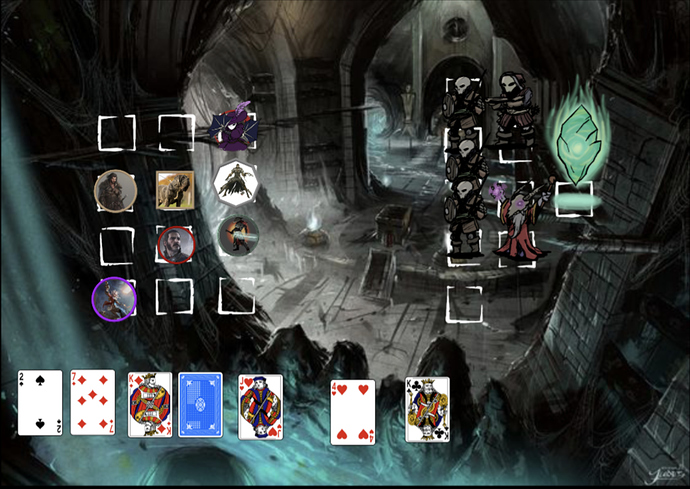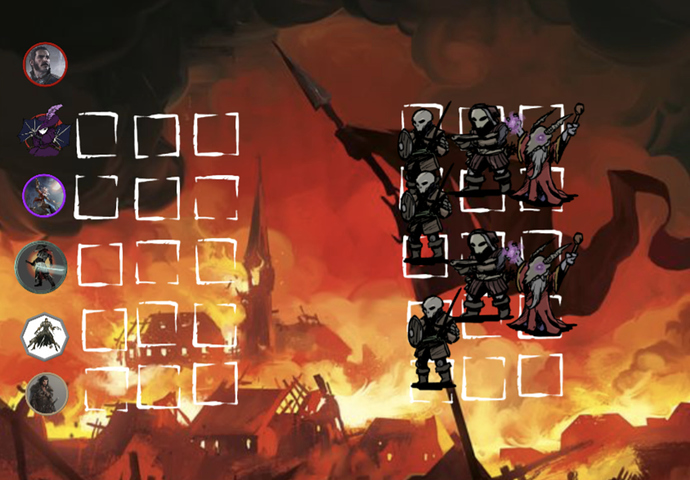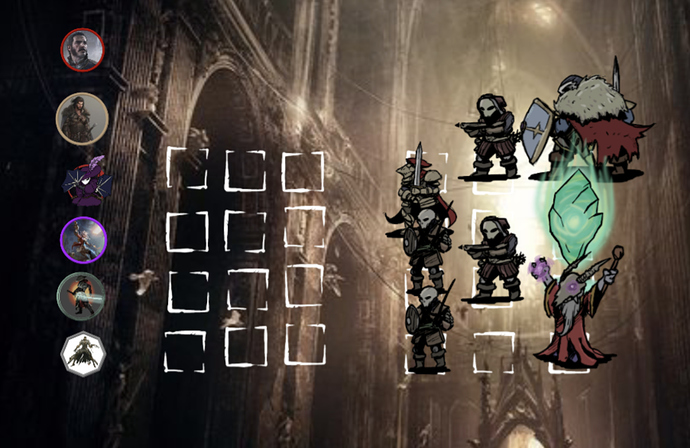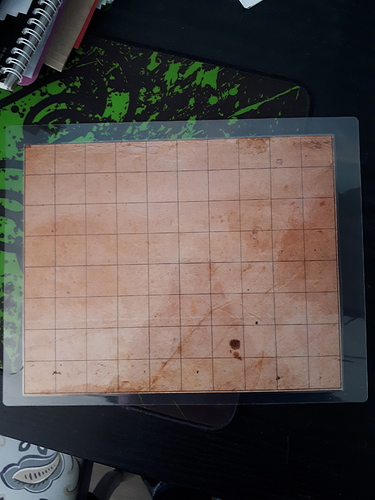I posted a pic of a recent VTT game that I got a few questions about, so I thought I’d share my quick workings on it. It was the result of a lunch break at work, so wherever there’s an empty spot or something that can use more work, feel free to workshop it.  Also, here’s a terrible graphic to help me explain some stuff. This was inspired by JRPGs, Darkest Dungeon, Battle Chasers Night War, and the Dark Souls board game.
Also, here’s a terrible graphic to help me explain some stuff. This was inspired by JRPGs, Darkest Dungeon, Battle Chasers Night War, and the Dark Souls board game.
Premise: All people involved in combat line up similar to turn based JRPGs to simplify movement. Design combat with character density as opposed to spatial density.
Rows and Attacking: The middle of the map is the “eye of the storm” so the enemy ranks abide by the same Close/Near/Far setup as the players. You cannot target a creature that is behind another creature, they are being protected. You may only attack a creature that is directly across from your or directly diagonal to you. This is simple, so if you want to make it a little deeper try these things:
- Range Increments: 1 handed weapons have to be used on your front row to attack their front row. But 2 handed weapons can be used to attack 1 row further, meaning you could attack their second row (Near) while on your first row (Close) or attack their first row by being on your second. Ranged weapons have effective ranges based on how many rows they can shoot through: a range of 3 means you can hit their front row from your back row, and by moving forward you can hit further back. A range of 5 means you could shoot their back row while on your back row.
Some attacks/effects may attack a lane or a row, like a grenade attacking a whole row or a piercing attack getting a lane. Spell targets, wild weapons, special abilities, there’s too much to even try o put in here: get creative, get nuts!
Movement: You can move 1 space on your turn, moving laterally or changing rows. If you sac your attacking/misc action you can move 2 spaces. If you move into a space occupied by another player you switch places with them (since you’re moving relative to the eye of the storm). You can use this to help move your team mates into better positions by relatively shifting the battlefield.
- Moving enemies: You may use your movement action to “Charge” a single enemy and move them closer by 1 row, making them relatively closer for the party. You may use your action to “Shove” an enemy to the side or back one row provided you both are on your front rows. If you have a weapon/ability that has Knockback you can push enemies back a single row. Remember, any overlapping movement into occupied squares results in them switching places. Use team tactics to shake things up, and use enemy formations to really stump players trying to get to the baddies at the back!
Using Items: To use an item on a party member you need to be in the same row. Use your own judgement because that’s a fast and loose rule aimed more at dispensing potions, helping a friend up, or something similar. Throwing a Molotov cocktail? Probably don’t want to be on the same row when that goes off.
Designing your Environments: This is a really strong element of this set up, probably my favorite part. You can quickly and easily give your encounters a lot of character by putting in the details of your environment according to rows, background, and of course the all-powerful 3 T’s! There’s an infinite amount of ways to get creative here, so let’s just get through a couple examples:
-
Background: there’s an element in the background that blasts arcane bolts, quakes the ground, or heals the baddies on a Timer. Maybe it can be attacked, maybe it’s a sort of puzzle, or maybe the elements to interact with it are on the player’s side of the grid somewhere. You can have a background element for the enemies, players, both, or a single global element. Whatever this element is, it’s built to help you tell the story of where players are at. It can be a security system launching waves of drones at players until shut down, 2 mechs doing battle and assisting players, or a Final Fantasy “Summon” style element players can call on to help every so often (as was the case in my game).
-
Threats: Feeling devious? Assign a number to the player grid squares and target them somehow. A building explodes nearby and rains down flaming rubble on 3 random squares. A tricky enemy has trapped certain squares and if players aren’t searching for them they may end up triggering them. A “trap” on the battlefield may attack a whole row, like the roof caving in d4 rounds from the start of combat. It’s not just the enemies players have to worry about, it’s their dangerous environment too, and now you don’t have to worry about which part of the map it affects or whether players will walk over the 5’ square that has the trap on it. Fast and easy, but has a lot of depth.
-
Treats: Don’t forget about these delicious fellas, and they can come out in spades! Give rows and squares mechanical benefits. A row might get a bonus to Armor against ranged attacks because of all the large rubble/cover opportunities in it, or it may be a single square protected by a portable energy shield. Using certain skills in certain squares might give players advantage too! Like a computer terminal in a certain square might allow a character to activate the laser system on the baddies’ side with a successful Int check every d4 rounds. They could get bonuses to attacks from favorable positioning, protection from environmental hazards, or a TON more. Make spaces fun and interesting, telling the story of what the battlefield is like.
-
Get Tricky: “hide” elements on the enemy side of the battlefield to change the dynamics. Darkness was an issue in one of my encounters, making it difficult for ranged characters to be as effective. There was a light fixture on the enemy side that players spied and used a fire bomb to light it up and negate the darkness. Put a structural beam over there for players to destroy and drop massive damage on the enemy ranks!
Well, there’s a quick primer on it. I’ve probably left out some mission critical info, but I’m just writing stuff down as I remember it, haha. There’s a lot more to it, and a lot more to discover, but I’ve had a blast messing with it. Bonus is it’s pretty familiar to most players so it’s easy to relate to them as a game to be played than a simulation to manipulate. Got cool ideas? Did this spark your imagination? Drop a comment so we can learn from your wisdom! 
Here are a few more pics of set ups from our light play testing of it.

